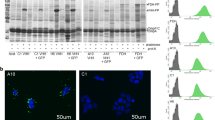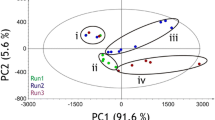Abstract
The use of biosensor technology is described to address in real-time the production and subsequent purification of a bioactive recombinant protein product. The product, D1.3 Fv antibody fragment, was expressed in Escherichia coli and purified via two process routes, one for extracellular and one for intracellular product material. The cells were harvested by centrifugation in a solid bowl CARR Powerfuge and stored at −70°C. Clarification of the supernatant was performed by depth filtration, followed by affinity chromatography for final purification of the extracellular product. To purify the intracellular product the harvested cells were resuspended and homogenised. Removal of debris in the CARR Powerfuge was followed by depth filtration and affinity chromatography. In this work we have shown the rapid determination of bioactive product levels, and the impact this has on improved accountability and confidence is demonstrated in process mass balances on the product using the data acquired during process operation.




Similar content being viewed by others
References
Von Stockar U, Van der Wielen LAM (1997) Thermodynamics in biochemical engineering. J Biotechnol 59:25–37
Bracewell DG, Gill A, Hoare M, Lowe PA, Maule CH (1998) An optical biosensor for real-time chromatography monitoring: Breakthrough determination. Biosens Bioelectron 13:847–853
Varga E, Titchener-Hooker NJ, Dunnill P (2001) Prediction of the pilot scale recovery of recombinant yeast enzyme using integrated models. Biotechnol Bioeng 74:96–107
Boychyn M, Doyle W, Bulmer M, More J, Hoare M (2000) Laboratory scale-down of protein purification processes involving fractional precipitation and centrifugal recovery. Biotechnol Bioeng 69:1–10
Pate ME, Thornhill NF, Turner MK, Titchener-Hooker NJ (1999) The use of principal component analysis for the modelling of high performance liquid chromatography. Bioprocess Engineering 21:261–272
Glassey J, Iganova M, Ward AC, Montague GA, Morris AJ (1997) Bioprocess supervision: Neural networks and knowledge based systems. J Biotechnol 52:201–205
Schugerl K (2001) Progress in monitoring, modelling and control of bioprocesses during the last 20 years. J Biotechnol 85:149–173
Richardson P, Molloy J, Ravenhall R, Holwill I, Hoare M, Dunnill P (1996) High speed centrifugal separator for rapid on-line sample clarification in biotechnology. J Biotechnol 49:111–118
Habib GB, Holwill I, Hoare M (1997) Rapid piloting of a selective flocculation process for product purification. J Biotechnol 59:91–101
Willoughby NA, Habib G, Hjorth R, Hoare M, Titchener-Hooker NJ (2000) The use of rapid on-line monitoring of products and contaminants from within an expanded bed to control separations exhibiting fast breakthrough characteristics and to maximise productivity. Biotechnol Bioeng 70:254–261
Middendorf C, Schulze B, Freitag R, Scheper T, Howaldt M, Hoffmann H (1993) On-line immunoanalysis for bioprocess control. J Biotechnol 31:395–403
Ozturk SS, Thrift JC, Blackie JD, Naveh D (1995) Real-time monitoring of protein secretion in mammalian cell fermentation: Measurement of monoclonal antibodies using a computer-controlled HPLC system (BioCAD/RPM). Biotechnol Bioeng 48:201–206
Polzius R, Bier FF, Bilitewski U, Jager V, Schmid RD (1993) On-line monitoring of monoclonal antibodies in animal cell culture using a grating coupler. Biotechnol Bioeng 42:1287–1292
Osborne M, Bracewell D, Dempsey J, Field R, Fish B, Rithie C (2001) Rapid estimation of human monoclonal antibody (IgG4) concentration in cell culture supernatants. In: Lindner-Olsson E, Chatzissavidou N, Lullau E (eds) Animal cell technology: From target to market. Kluwer pp 463–465
Gill A, Bracewell DG, Maule CH, Lowe PA, Hoare M (1998) Bioprocess monitoring: An optical biosensor for rapid bioproduct analysis. J Biotechnol 65:69–80
Bowering LC, Bracewell DG, Keshavarz-Moore E, Hoare M, Weir ANC (2002) Comparison of techniques for monitoring antibody fragment production in E.coli fermentation cultures. Biotechnol Prog 18:1431–1438
Bracewell DG, Gill A, Hoare M (2002) An in-line flow injection optical biosensor for real-time bioprocess monitoring. Trans Inst Chem Eng 80(C):71–77
Bracewell DG, Brown RA, Gill A, Hoare M (2001) Monitoring and control of bioproducts from conception to production in real-time using an optical biosensor. Eng Life Sci 1:25–31
Ryan W, Parulekar SJ, Stark BC (1989) Expression of β-lactamase by recombinant Escherichia coli strains containing plasmids of different sizes-effects of pH, phosphate and dissolved oxygen. Biotechnol Bioeng 34:309–319
Gregory ME, Turner C (1993) Open-loop control of specific growth rate in fed-batch cultures of recombinant E. coli. Biotechnol Tech 7:889–894
Ward ES, Gussow D, Griffiths AD, Jones PT, Winter G (1989) Binding activities of a repertoire of single immunoglobulin variable domains secreted from Escherichia coli. Nature 341:544–546
Holwill I, Gill A, Harrison J, Hoare M, Lowe PA (1996) Rapid analysis of biosensor data using initial rate determination and its application to bioprocess monitoring. Process Control Qual 8:133–145
Harrison JS, Keshavarz-Moore E, Dunnill P, Berry MJ, Fellinger A, Frenken L (1997) Factors affecting the fermentative production of a lysozyme-binding antibody fragment to Escherichia coli. Biotechnol Bioeng 53:612–622
Souzu H (1980) Studies on the damage to Escherichia coli cell membrane caused by different rates of freeze-thawing. Biochim Biophys Acta: Biomembranes 603:13–26
Clarkson AI, Lefevre P, Titchener-Hooker NJ (1993) A study of process interactions between cell disruption and debris clarification stages in the recovery of yeast intracellular products. Biotechnol Prog 9:462–467
Wong HH, O’Neill BK, Middelberg AJP (1997) A mathematical model for Escherichia coli debris size reduction during high pressure homogenisation based on grinding theory. Chem Eng Sci 52:2883–2890
Bracewell DG, Gill A, Hoare M (2002) An in-line flow injection optical biosensor for real-time bioprocess monitoring. Trans Inst Chem Eng 80(C):71–77
Bailey JE, Ollis D (1986) Biochemical engineering fundamentals, 2nd edn. McGraw-Hill, New York
Acknowledgements
The support by the Engineering and Physical Sciences Research Council (EPSRC) for the Innovative Manufacturing Research Centre (IMRC) for Bioprocessing is gratefully acknowledged. The IMRC is part of the Advanced Centre for Biochemical Engineering at UCL, and the support of the collaborating companies is also gratefully acknowledged.
Author information
Authors and Affiliations
Corresponding author
Rights and permissions
About this article
Cite this article
Bracewell, D.G., Brown, R.A. & Hoare, M. Addressing a whole bioprocess in real-time using an optical biosensor-formation, recovery and purification of antibody fragments from a recombinant E. coli host. Bioprocess Biosyst Eng 26, 271–282 (2004). https://doi.org/10.1007/s00449-004-0359-z
Received:
Accepted:
Published:
Issue Date:
DOI: https://doi.org/10.1007/s00449-004-0359-z




